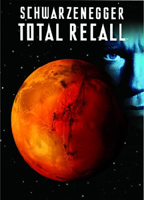
Arch
443/646: Architecture and Film
Fall 2005
Total Recall
(1990)
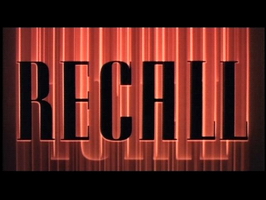
 |
Arch
443/646: Architecture and Film Total Recall |
 |
Discussion
Questions:
Please answer the questions below. Use paragraph form. Your answer should be around 400 words. Email me your responses in Word .doc format to: tboake@sympatico.ca I will be posting these each week after the class. You should be prepared to deliver your answer in class -- but paraphrase, do not read it.
The science fiction writings of Philip K. Dick have inspired many film visions of the future. "Do Androids Dream of Electric Sheep" was used as the basis for the film "Blade Runner" (1982), directed by Ridley Scott. "Minority Report" (2002), directed by Steven Spielberg, was also inspired by a the short story of the same name. The movie "Paycheck" (2003), directed by John Woo was also based upon the short story of the same name. "A Scanner Darkly", due to be released in 2006, is based upon the Philip K. Dick story of the same name, written in 1977. Check out the cast... Teaser for "A Scanner Darkly"... Like a graphic novel come to life, "A Scanner Darkly" will use live action photography overlaid with an advanced animation process (interpolated rotoscoping) to create a haunting, highly stylized vision of the future. The technology, first employed in Richard Linklater’s 2001 film "Waking Life," has evolved to produce even more emotional impact and detail. Interestingly, they managed to spell Dick's
name incorrectly in the credits for "Total Recall". |
| Artwork for Total Recall: |
A film such as
"Total Recall" requires much effort in the conception of the "worlds"
in which it will eventually be shot. This artwork established the colour
and flavour of the film.
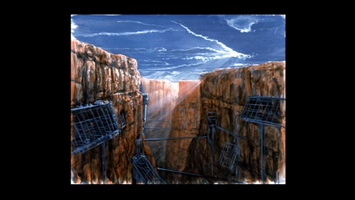 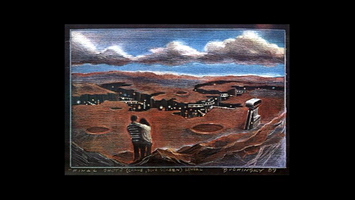 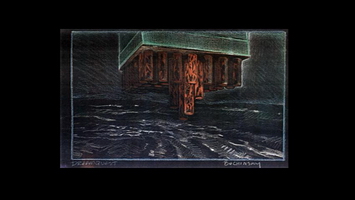 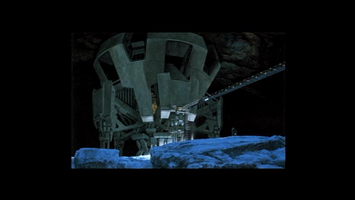 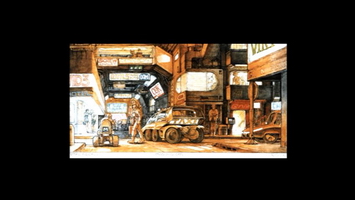 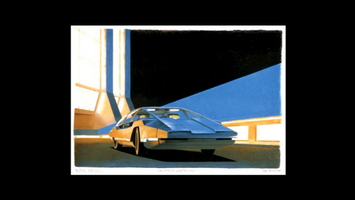 |
| Artwork for Total Recall: |
The storyboards work through the action and sequence development of the film and provide an order for the shooting sequence and communicate necessary information about the sets and scenes to be constructed.
|
updated
27-dec-05 3:04 PM
1. B J Smith Most futuristic sci-fi movies tend to choose one of two ways of presenting the future. One consisting of a highly layered and weathered city – where over the years much building and industry have left the major cities in a compilation of past and future, where many years of development are observable even through the latest layer of technology of the future. Often the under tone of this presentation suggests a gritty and unforgiving view of the future – dystopia. Such is the case with films like Blade Runner, The Fifth Element and The Terminator. The other presentation, which appears to be the case with Total Recall, presents the future city in more of a Utopian milieu – where the city appears cleaner and more organized than what the current norms of the day are. Not only do these views of the future try and present the great wonders of technology to come, but they also often neglect the past, presenting a city which has little remnants of the city of yesteryear. Other films which share this notion are 2001: Space Odyssey or any of the Star Trek films. The new brutalist architecture of Mexico City is an ideal back drop for presenting a futuristic city of this Utopian view. Its clean lines, simplistic form and lack of any historical reference accomplish the futuristic feel - placing the audience in an unknown cityscape, capable of relieving the future of any preconceived notions and references. Likewise, the materials of the architecture also help to present this fantastical view, as much concrete, steel and glass was used in the architecture – all depicting highly developed means of construction, most notably the monolithic forms of concrete. This uniform and organized style helps create a modern hi-tech feel to the interiors, and not only is it attempting to envision the future but it also sets the tone about the way things will proceed – orderly, clean and sanitary. All these images for the future depict it full of progress, presenting the idea that anything is possible, and further developing the fantasy of the story. The expression of futuristic technology that normally is seen across many aspects of the set designs, are easily extracted from the existing architecture used in Mexico City, and therefore was successful in creating a futuristic view for Total Recall. |
||
2. David Takacs The well-known film Total Recall instantly calls to mind its even more celebrated main actor and star, Arnold Schwarzenegger. However, it should not be remembered exclusively for this as it is a film that takes an important role in the developing register of time-piece space films. While there are many aesthetic similarities between it and other films of the genre, including an extension of the dominant themes of geometric shapes and hard materials, Total Recall takes these subjects and creates its own aesthetic for the film. This aesthetic has numerous manifestations. Here we will focus on the representation of vehicular transportation, and whether this is effective or ‘enough’ in relation with the design of automobiles in 1990, the year Total Recall was released. In examining the vehicular transportation in Total Recall, it is important to note that one of the primary strategies used is similar to that used by countless other science fiction films, the appearance of geometric shapes. The use of multiple faces is part of an attempt to create new forms that are unknown to the audience, creating the sense of a future, regardless of the logic behind the move. In the end, the designs for the vehicles appeal to the latent desire for a sports car look. Not only does the film attempt to differentiate, it also tries to use appealing and fantasy-like precedents. It could be said that the designs are a bit over the top though, with many more faces than realistically imaginable, not to mention the protruding car body around the wheels. When compared to the vehicles of its time, Total Recall’s vehicles are ultimately not that different. Cars at the time had gull-wing doors, the extra faces above the wheels are purely extraneous, and a third set of wheels could hardly help. When looked at with the top cars, it even falls short. The Lamborghini Diablo, introduced the same year, is already miles ahead of Total Recall’s designs. Even its outgoing Countach – in existence for nearly 10 years – seems to be of a more successful type. Although these examples are by no means ordinary, they are nonetheless well-known by most. Even typical cars, although generally more box-like (but with less faces), were not so dissimilar from those in the film. Perhaps the most glaring mistake is that while their cars appear to fragment the cars body even more, the trend as witnessed through time is to strive to achieve more and more ‘pure’ forms, resulting in a better aerodynamic profile. In the end, does this matter? The answer is no. Total Recall didn’t set out to make a realistic future-thriller such as films like 2001: A Space Odyssey. Rather, it sought to create a somewhat gritty, action-filled, and at times humorous blockbuster film. In that regard, it was a great success. |
x | |
3. Andrea Wong In this film, animatronics were either used subtly as part of costume or obviously as props and comical characters. Both uses contribute to the futuristic effect of the film, by making the general aesthetic more believable and by showing technological sophistication using machines to imitate humans. The most notable use of an “animatronic” as part of a costume
is the offsetting character of the rebel leader attached to the larger
figure’s abdomen. The viewer is unaware of the exact technique used
to animate him while watching the film. In the fantasy world created by
the story, this character blends in as a living, talking creature. There are two significant examples of the second use of animatronics in this movie. Firstly, the robotic drivers in the taxis take on a more or less human form that is obviously meant to be unrealistic and instantly recognizable as comical. These characters are merely machines with painted plastic covers and they represent the dry and insensitive reality of technology. The future is that of anonymous automation. The last use of an “animatronic” is the large female “costume” Schwarzenegger’s character wears to cross the Martian border. Although probably played by a real person, the viewer is led to believe that this is in fact an electronically animated shell used as part of a very elaborate disguise. It is shown opening up to reveal the human that is wearing it. This contributes to the futuristic effect of the film because it implies that they are able to imitate human likeliness and form by using very sophisticated machines, something today’s society (certainly not the one of the 90s) has not yet accomplished. |
||
4. Derek
McCallum The use of the Martian models is very important in the film, as they are the only view we see of the inhabitation and built form that sustain the people of Mars. The models themselves are very large, which allow them to be built at a more reasonable level of detail than much smaller ones. This gives a much greater sense of depth and volume, which make them more believable as well as effective. The clips we see of the models are quite short, and are often panning or moving, so we are unable to see them for long. This is actually quite an effective technique, because it allows the viewer to fill in the parts they didn’t catch to the whole the director has shown them. The model of the Martian settlement also explains how the built form is related to the landscape. We see that the walls of glazing are actually built into the sides of the canyon, indicating that the buildings are essentially carved into the rock. They do not just sit in the landscape, but are built into it. The intense red of the rock gives a very vivid image of the conditions on Mars, which is accentuated by the dull rusty colours of the built model. The model is effective at creating an image of Mars as a raw and inhospitable place. |
||
5. Helen
Pallot Food is represented to express the everyday workings and habits of the characters. On earth the food is represented as natural products, such as the scene where Schwarzenegger prepares a smoothie for breakfast. He uses liquids and powders, ingredients that come in bottles and are that are pureed to create a meal that can satisfy a fully grown male. The use of white bottles and clear glass portray the ideas of a clean and healthy environment. The food on mars is represented in public settings as opposed to the private breakfast setting on earth. These scenes are represented in dinner like environments, like large eateries. This may echo the idea that life on mars is more programmed, that because of the conditions everything is programmed and accounted for. There wouldn’t be any markets or have a variety of groceries at any stall. The problems of food, like in any environment that is restricted and isolated can be solved by bulk feeding the masses. Throughout the movie, there are a larger amount of glasses and drinks than there is food. The later scenes on Mars when the planet is transforming, there are a lot of milk shake like glasses shattered throughout the tables. This may have been an easy way of representing food, or it could be seen as food has become predominately liquids rather than solids. Maybe that we have come so advanced that we no longer have to chew when eating. |
||
6. Allison
Janes In Total Recall the main character has an unexplainable desire to leave earth for mars. The lack of vegetation in the urban environment reflects the distaste that Arnold’s character has for the mundane and anonymous life on earth. The film primarily uses concrete as the building material. It is modular, almost colourless, and hard. This is reflective of the unyielding monotony that the character is experiencing on earth and furthers the notion that his life is entirely contrived and predictable; there is no chaos as everything is man made. Nature has been relegated to the periphery of human existence because it cannot be controlled and manipulated according to our own wishes. Therefore it is fitting that Arnold’s character is only able to access nature through the fabricated reality of a television projection. This nature is also a stereotypical depiction of the “great outdoors” as opposed to the actual reality of looking out the window while sitting at the breakfast table. The movie is devoid of vegetation because it questions what is real
and what is a contrived reality. The presence of nature implies that
there is some sort of uncontrollable reality, the chaos of the natural
world. |
||
7. Mat
Triebner Paul Verhoeven’s creation of the interior of the pyramid mine generator was indeed liberal. Yet what is heartening is that the mine generator did in fact find its roots in architecture, in those gloomy images of early 20 th century Manhattan skyscrapers, and to a greater extent, based on the reality of the operation of nuclear fission. The process, as described in the ‘making of’ of Total Recall is based on the control rods’ encounter with water which occurs within the reactor itself, resulting in the creation of steam and the turning of the turbines. Total Recall bases the forms of the interior of the pyramid mine generator on these forms primarily, but additionally on the architectural images Verhoevan discusses in the special features portion of the DVD, which incidentally, were simply inverted to provide the necessary inspiration for the detailing of the volumes. It becomes shockingly apparent when contrasting the image of the high-rises in comparison to the image of the interior of the pyramid mine generator just how little evolution has occurred between the source image and the final image on the screen. This seems somewhat peculiar considering the importance placed on the mine generator, and the fact that its use isn’t limited to one scene, or even shot. Contrast this to the image of the exterior of the settlement, a model
which was no doubt created after hundreds of painful iterations of design
before construction could even begin. All that for an exterior shot which
was visible perhaps twice, if not once. Relatively speaking then, the
evolution of the pyramid mine generator perhaps did not go far enough.
Simply inverting an image of a highrise, although creating an interesting
space, could have used further development considering the great deal
of importance placed upon the scene in the final sequence of the film. |
||
8. Matt
Storus Comment on the use of video communication in the film. Is it credible? Does it seem technologically appropriate for the supposed "time" of the film? The use of video as the primary means of communication in Total Recall was conservative for the supposed time of the film; however it was wholly appropriate for the era in which the movie itself was made. Additionally, the use of video screens is effective in portraying the main theme of the movie – the uncertainty of reality. According to Phillip K Dick’s website, the film is intended to take place in the later-part of the 21 st century, and as such the actual screen technology is not particularly innovative. There are many movies in which the projection of images is done in a much more interesting way, as opposed to the predominant cathode-ray curved-screen look. One interesting use, however were the wall-panel screens that generated the “view” inside Arnold’s apartment. Granted, the screens find their way into a variety of settings and objects, however none were particularly innovative as compared to the proliferation of video projection technology in 1990. For the time period, however, using video as a means of ubiquitous communication was a useful commentary on the times. The movie came out in the midst of the MTV generation, where television had become the principle mode of media. Lastly, the use of video imagery was also effective in the portrayal
of the plot and its themes. Through the film, the audience is meant to
question whether Arnold’s character is actually living through
these events, or if instead it is part of the fantasy he purchased. In
this way, the screens enhance this indeterminacy, because by nature they
only depict outward signs that are, in fact, a carefully constructed
reality (as opposed to a direct perceptual reading of reality). |
||
9. Elfie
Kelfakis Comment on the notion of the plot that has the "world leader/despot" holding the people ransom so that they can earn "air". (Interestingly enough, lack of air, or plenty of bad air on the set in Mexico City caused extreme health problems for the director, cast and crew).
|
||
10. Nathan
Rehorick I think that, like in Outland, the necessities of constructing a space-based mineral mining colony dictates a certain quality of space on Mars versus on Earth. The availability of atmosphere on earth allows people to survive in open-air environment and means that structures can be built at and above grade. The lack of atmosphere on Mars, however, pushes the mining structures underground and into the bedrock. In most Mars scenes there is a strong sense of air-tightness; all spaces are sealed from outside. So, it would seem sensible and much easier to carve underground spaces rather than to try and create free-standing structures above ground. Hence the predominance of rock in the interior environments of Mars. In compliment, steel has a high strength-to-weight ratio compared to concrete, making it possible to prefabricate much of the colony structures on earth, and then transport them to Mars for assembly. Metal is also the local or vernacular material (uridium), so we might even speculate that it is processed and refined right on the plant. If concrete structures were used on Mars, one would have to wonder where this resource was coming from. There are, of course, cinematic issues involved here, too. There is a layering of spaces from the outermost public areas (such as Venusville), where glass domes provide views to outside, to the most secretive hide-out areas of the rebellion, which are accessible only by moving deeper and deeper into the bedrock through progressively heavier and heavier metal doors. So, the heavy rock-like character of various environments seems to reflect its public or private nature. This differentiation is dramatically emphasized when Quaid and Melina burst into the reactor chamber after having wandered through a labyrinth of tunnels. This provides an interesting contrast to Earth/Mexico City where people are essentially blandly-dressed, undifferentiated workers who go about their business in a uniform manner. This is, after all, where Quaid is dumped after having his memory erased. The dull uniformity of concrete on Earth reflects this thematic idea of memory loss. In sum, I found that the use of concrete on Earth versus the use of
metal and raw rock on Mars to be quite relevant in terms of the practicalities
of building structures on a remote planet that has no atmosphere, and
fairly effective as a cinematic device that not only emphasizes these
technical issues, but also reinforces the theme of memory loss and re-discovery. |
||
11. Emily
Maemura In terms of safety, it seems unlikely that large expanses of glass would provide any safety whatsoever on a planet with no breathable atmosphere, where people’s heads explode when exposed to the martian air. Perfectly hermetic seals on multi-storey glass volumes seem another difficult task in martian construction, nevermind transportation to mars and/or manufacter of these glass sheets on mars itself. The only means of safety I can see it providing is to discourage the shoot ‘em up fighting scenes so prevalent throughout the films (on mars and earth), perhaps explaining why no uprisings or revolutionary battles could take place within this glass box (pre-Arhnold Schwarzenegger). As a plot device, besides saving the main characters from being shot, the glass serves to reinforce the alien nature of the planet, allowing the red landscape to be viewed at all times, the only natural light always has a tint of fiery red. This allows for a great contrast with the calming blue sky representing the breathable atmosphere in the end of the film. |
||
12. Liana
Bresler The circular geometry of the future in this film seems to relate the advent of new technologies to the impression of time becoming cyclical and unquantifiable. The new technologies of the future collapse notions of identity, time, and space making the passage of time undistinguishable and irrelevant. When the structures left behind by the ancient Martian civilization are discovered, they are also circular in form, thus implying that the old is identical to the new, and that time has reverted on itself. This civilization achieved the collision of time and space before humans were able to by developing sophisticated technologies. The circular geometry contrasts with the hexagonal representation of movies made prior to this movie. In the information age, circular and curved forms are considered to be indications of technological advancements because they are often the results of computer-generated and calculated shapes that are aerodynamic and efficient. Furthermore, the construction of curves and circles tends to be more complicated and hence more advanced than that of rectilinear shapes. These are also best suited to newer materials such as plastics and other synthetics, other inventions of recent times. The use of hexagonal geometry that was common in earlier movies in this case would have seemed outdated and out of place. There are many other elements in the movie that reflect early 90’s culture, such as the use of multiple television screens and the fashion. It therefore seems more probable that the use of circular geometry in the movie is more a reflection of the period in which the movie was made rather than a symbolic representation.
|
||
13. Maia |
||
| x | 14. Davide Total Recall was shot with a budget of 60 million dollars and we can see every single dollar in the film’s special effects. The impact of gadgets and special effects in the Total Recall is deep. As in every Sci-fi film gadgets are studied very carefully. Sometimes they are protagonist, sometimes they don’t play an important role in the plot but they are usually the most important tool the director has to take us into the future, into another world. Total Recall develops gadgets inspired by the real things of the nowadays life, starting from the present scientific knowledge and going forward, forecasting the future with fears and wishes of the present society. These gadgets seem very appropriate with the surrounding furniture and the other architectures of the film. In Total Recall these devices are not so futuristic, sometimes they seems traditional weapons, the air engine on Mars is a common giant fan, the public transportation in Chicago is not very different from a traditional subway, the taxi cabs have a surreal automatic driver. Like in Blade Runner, the future is more decadent than the present. As in other movies like Blade Runner, the gadgets in the film have a very important task. We have the same situation basically in all Sci-Fi films inspired officially or not by Philip Dick’s books: Minority Report, Matrix,The Truman Show. They should be able to solve a fundamental question, the doubt of the true identity of the man: is a real human or is an android ? (Blade Runner). What’s real Quaid identity? What are his memories ? (Total Recall). These machines don’t solve the doubt, they make it worse. Only the human mind at the end of the film can “light the light” and reach the truth. If Blade Runner is a good transposition of Dick novel, in Total Recall the plot is based on a gadget, the Recall machine, but the special effects move the plot away from the original Philip Dick plot and from the philosophical aspect of the novel in favour of an hollywoodian happy ending. |
|